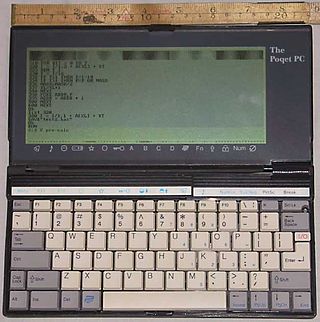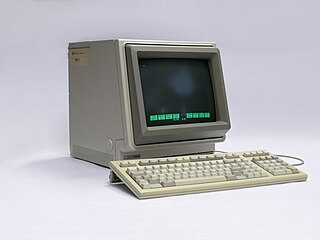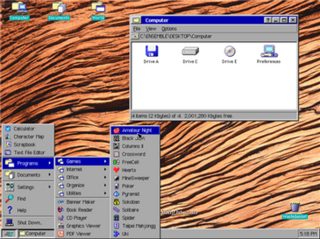
A Pocket PC is a class of personal digital assistant (PDA) that runs the Windows Mobile or Windows Embedded Compact operating system that has some of the abilities of modern desktop PCs. The name was introduced by Microsoft in 2000 as a rebranding of the Palm-size PC category. Some of these devices also had integrated phone and data capabilities, which were called Pocket PC Phone Edition. Windows "Smartphone" is another Windows CE based platform for non-touch flip phones or dumber phones.

The Poqet PC is a very small, portable IBM PC compatible computer, introduced in 1989 by Poqet Computer Corporation with a price of $2000. The computer was discontinued after Fujitsu Ltd. bought Poqet Computer Corp. It was the first subnotebook form factor IBM PC compatible computer that ran MS-DOS. The Poqet PC is powered by two AA-size batteries. Through the use of aggressive power management, which includes stopping the CPU between keystrokes, the batteries are able to power the computer for anywhere between a couple of weeks and a couple of months, depending on usage. The computer also uses an "instant on" feature, such that after powering it down, it can be used again immediately without having to go through a full booting sequence. The Poqet PC is comparable to the HP 95LX/HP 100LX/HP 200LX and the Atari Portfolio handheld computers.

HP-150 was a compact, powerful and innovative computer made by Hewlett-Packard in 1983. It was based on the Intel 8088 CPU and was one of the world's earliest commercialized touch screen computers. Like other "workalike" IBM PC clones of the time, despite running customized MS-DOS versions 2.01, 2.11 and 3.20, the machine was not IBM PC DOS compatible. Its 8088 CPU, rated at 8 MHz, was faster than the 4.77 MHz CPUs used by the IBM PC of that period. Using add-on cards, main memory could be increased from 256 KB to 640 KB. However, its mainboard did not have a slot for the optional Intel 8087 math coprocessor due to space constraints. An HP-150 with an optional hard disk was called HP Touchscreen MAX.

The Atari Portfolio is an IBM PC-compatible palmtop PC, released by Atari Corporation in June 1989. This makes it the world's first palmtop computer.

GEOS is a computer operating environment, graphical user interface (GUI), and suite of application software. Originally released as PC/GEOS, it runs on DOS-based, IBM PC compatible computers. Versions for some handheld platforms were also released and licensed to some companies.

The HP 200LX Palmtop PC, also known as project Felix, is a personal digital assistant introduced by Hewlett-Packard in August 1994. It was often called a Palmtop PC, and it was notable that it was, with some minor exceptions, a MS-DOS-compatible computer in a palmtop format, complete with a monochrome graphic display, QWERTY keyboard, serial port, and PCMCIA expansion slot.

A handheld personal computer (PC) is a pocket-sized computer typically built around a clamshell form factor and is significantly smaller than any standard laptop computer, but based on the same principles. It is sometimes referred to as a palmtop computer, not to be confused with Palmtop PC which was a name used mainly by Hewlett-Packard.

The Jornada was a line of personal digital assistants or PDAs manufactured by Hewlett-Packard. The Jornada was a broad product line that included Palm-Size PCs, Handheld PCs, and Pocket PCs. The first model was the 820, released in 1998, and the last was the 928 model in 2002 when Compaq and HP merged. The Jornada line was then succeeded by the more popular iPAQ model PDAs. All Jornada models ran Microsoft Operating Systems that were based on Windows CE.

HP OmniBook was a range of laptop personal computers created by Hewlett-Packard, introduced in 1993. The range was discontinued following the acquisition of Compaq by Hewlett-Packard in 2002, with the Compaq Presario, HP Compaq, and HP Pavilion laptops succeeding the OmniBook line.

The HP 95LX Palmtop PC, also known as project Jaguar, was Hewlett Packard's first MS-DOS-based pocket computer, or personal digital assistant, introduced in April 1991 in collaboration with Lotus Development Corporation. It can be seen as successor to a series of larger portable PCs like the HP 110 and HP 110 Plus.

Following the introduction of the IBM Personal Computer, or IBM PC, many other personal computer architectures became extinct within just a few years. It led to a wave of IBM PC compatible systems being released.
Smartphone & Pocket PC was published every two months by Thaddeus Computing and covered Windows Mobile devices, software, and accessories. It included news, tips, articles, reviews, how-tos, and an enterprise section. Its headquarters was in Fairfield, Iowa.

DOS is a family of disk-based operating systems for IBM PC compatible computers. The DOS family primarily consists of Microsoft's MS-DOS and a rebranded version, IBM PC DOS, both of which were introduced in 1981. Later compatible systems from other manufacturers include DR-DOS (1988), ROM-DOS (1989), PTS-DOS (1993), and FreeDOS (1998). MS-DOS dominated the IBM PC compatible market between 1981 and 1995.

HP Vectra was a line of business-oriented personal computers manufactured by Hewlett-Packard. It was introduced in October 1985 as HP's first IBM-compatible PC.
In computing, a hardware code page (HWCP) refers to a code page supported natively by a hardware device such as a display adapter or printer. The glyphs to present the characters are stored in the alphanumeric character generator's resident read-only memory and are thus not user-changeable. They are available for use by the system without having to load any font definitions into the device first. Startup messages issued by a PC's System BIOS or displayed by an operating system before initializing its own code page switching logic and font management and before switching to graphics mode are displayed in a computer's default hardware code page.
The Sharp PC-3000 was an MS-DOS-based palmtop computer introduced in 1991. The "SPC" was designed and developed by Distributed Information Processing Research Ltd. ("DIP") in the UK. DIP had earlier designed the Atari Portfolio and the two machines shared many design features both in hardware and software.
Pocket-sized computer describes the post-programmable calculator / pre-smartphone pocket-sized portable-office hardware devices that included the earlier DOS-based palmtops and subsequent Windows-CE handhelds, as well as a few other terms, primarily covering the 1980s through 2007.

Vadem Inc., later Vadem Limited, was an original design manufacturer, chipset designer, and computer design firm active from 1983 to 2013. The company chiefly focused on the design of mobile computers such as laptops, rendering their services to companies such as Zenith Data Systems, Osborne Computer Corporation, and Sharp Corporation, among others. In the late 1990s, the company released their own branded product, the Vadem Clio, a PDA.














